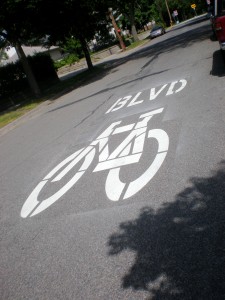 Yesterday was the big day, finally. After several “delivery dates” came and passed, on May 1, 2012 the FHWA finally delivered the Non-Motorized Transportation Pilot Program report (PDF). I wrote quite a bit about it at Streets.MN yesterday.
Yesterday was the big day, finally. After several “delivery dates” came and passed, on May 1, 2012 the FHWA finally delivered the Non-Motorized Transportation Pilot Program report (PDF). I wrote quite a bit about it at Streets.MN yesterday.
Your quick summation is: Yeah, when you spend $25 million dollars to shift demand and modeshare, you shift demand and modeshare. There’s a certain extent to which this conclusion should merit a hearty “duh” from pretty much everyone. (Give me $25 million bucks, and I bet I can make a few people believe the health benefits of breaking beer bottles and using the glass shard as pasta sauce. Marketing!)
The big challenge is going to be how different people feel about the value of these shifts. The ROI, if you will.
For $100 million dollars — the total investment across four pilot sites, including Minneapolis — you can typically build about five miles of four-lane highway in an urban/suburban area. It doesn’t get you very far. (For comparison, the St. Croix Bridge to Sprawl? It’s going to cost a hearty $600 million or more, to serve roughly 12,000 vehicles/day.) So you might think the following numbers would seem like good value:
- For the four pilot communities, bicycling mode share increased 36 percent, walking mode share increased 14 percent, and
driving mode share decreased 3 percent between 2007 and 2010. In Minneapolis, bicycling mode share increased by 33% and walking mode share increased by 17%. - In 2010, an estimated 16 million miles were walked or bicycled that would have otherwise been driven – 32 million total driving miles were averted between 2007 and 2010.
- The pilot communities saved an estimated 22 pounds of CO2 in 2010 per person or a total of 7,701 tons. This is equivalent to saving over 1 gallon of gas per person or nearly 1.7 million gallons from 2007 to 2010.
Approximately $89 million of the $100 million was spent directly on infrastructure. In the Twin Cities, it was actually near 87%, with many projects still in progress — or, roughly $21 million in infrastructure spend. There are citable studies that say building bike infrastructure builds jobs pretty efficiently. (I’d have loved to see figures on job creation in this report, but I doubt it was tracked, especially in the early years.)
From here, the debate moves to the ongoing standoff over transportation enhancements and the transportation bill. I think a certain level of angst is yet to come concerning the maintenance and upkeep of the infrastructure that’s been created in the four communities — infrastructure everywhere is suffering right now. Money is being poured into “new” and existing is decaying. And let’s not even mention the Sabo Bridge, which is one of the local investments, and already facing problems.
Me? Imma go ride my bike.
